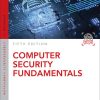Cybersecurity All in One For Dummies 1st Edition by Joseph Steinberg, Kevin Beaver, Ira Winkler, Ted Coombs 1394152872 9781394152872
$50.00 Original price was: $50.00.$25.00Current price is: $25.00.
Cybersecurity All-in-One For Dummies 1st Edition by Joseph Steinberg, Kevin Beaver, Ira Winkler, Ted Coombs – Ebook PDF Instant Download/DeliveryISBN: 1394152872, 9781394152872
Full download Cybersecurity All-in-One For Dummies 1st Edition after payment.

Product details:
ISBN-10 : 1394152872
ISBN-13 : 9781394152872
Author: Joseph Steinberg, Kevin Beaver, Ira Winkler, Ted Coombs
What is the size of the market: Tech security is a $150 billion business worldwide. Despite this spend, nearly 2/3rds of business report they have experienced some type of cyberattack over the past year.
Who are we targeting: This book provides an overview of cybersecurity measures that can be applied for business and personal use. Our primary target includes the audience of business owners and IT support pros who need a guide to making smart security choices and applying tools to defend their systems. The secondary audience includes personal technology users who have specific concerns about tech privacy and protection.
Cybersecurity All-in-One For Dummies 1st Table of contents:
Book 1: Cybersecurity Basics
Chapter 1: What Exactly Is Cybersecurity?
Cybersecurity Means Different Things to Different Folks
Cybersecurity Is a Constantly Moving Target
Looking at the Risks Cybersecurity Mitigates
Chapter 2: Getting to Know Common Cyberattacks
Attacks That Inflict Damage
Is That Really You? Impersonation
Messing around with Other People’s Stuff: Tampering
Captured in Transit: Interception
Taking What Isn’t Theirs: Data Theft
Cyberbombs That Sneak into Your Devices: Malware
Poisoned Web Service Attacks
Network Infrastructure Poisoning
Malvertising
Exploiting Maintenance Difficulties
Advanced Attacks
Some Technical Attack Techniques
Chapter 3: The Bad Guys You Must Defend Against
Bad Guys and Good Guys Are Relative Terms
Bad Guys Up to No Good
Cyberattackers and Their Colored Hats
How Cybercriminals Monetize Their Actions
Not All Dangers Come From Attackers: Dealing with Nonmalicious Threats
Defending against These Attackers
Book 2: Personal Cybersecurity
Chapter 1: Evaluating Your Current Cybersecurity Posture
Don’t be Achilles: Identifying Ways You May Be Less than Secure
Identifying Risks
Protecting against Risks
Evaluating Your Current Security Measures
Privacy 101
Banking Online Safely
Safely Using Smart Devices
Cryptocurrency Security 101
Chapter 2: Enhancing Physical Security
Understanding Why Physical Security Matters
Taking Inventory
Locating Your Vulnerable Data
Creating and Executing a Physical Security Plan
Implementing Physical Security
Security for Mobile Devices
Realizing That Insiders Pose the Greatest Risks
Chapter 3: Cybersecurity Considerations When Working from Home
Network Security Concerns
Device Security Concerns
Location Cybersecurity
Video Conferencing Cybersecurity
Social Engineering Issues
Regulatory Issues
Chapter 4: Securing Your Accounts
Realizing You’re a Target
Securing Your External Accounts
Securing Data Associated with User Accounts
Securing Data with Parties You’ve Interacted With
Securing Data at Parties You Haven’t Interacted With
Securing Data by Not Connecting Hardware with Unknown Pedigrees
Chapter 5: Passwords
Passwords: The Primary Form of Authentication
Avoiding Simplistic Passwords
Password Considerations
Creating Memorable, Strong Passwords
Knowing When to Change Passwords
Changing Passwords after a Breach
Providing Passwords to Humans
Storing Passwords
Transmitting Passwords
Discovering Alternatives to Passwords
Chapter 6: Preventing Social Engineering Attacks
Don’t Trust Technology More than You Would People
Types of Social Engineering Attacks
Six Principles Social Engineers Exploit
Don’t Overshare on Social Media
Leaking Data by Sharing Information as Part of Viral Trends
Identifying Fake Social Media Connections
Using Bogus Information
Using Security Software
General Cyberhygiene Can Help Prevent Social Engineering
Book 3: Securing a Business
Chapter 1: Securing Your Small Business
Making Sure Someone Is In Charge
Watching Out for Employees
Dealing with a Remote Workforce
Considering Cybersecurity Insurance
Complying with Regulations and Compliance
Handling Internet Access
Managing Power Issues
Chapter 2: Cybersecurity and Big Businesses
Utilizing Technological Complexity
Managing Custom Systems
Continuity Planning and Disaster Recovery
Looking at Regulations
Deeper Pockets — and Insured
Considering Employees, Consultants, and Partners
Looking at the Chief Information Security Officer’s Role
Chapter 3: Identifying a Security Breach
Identifying Overt Breaches
Detecting Covert Breaches
Chapter 4: Recovering from a Security Breach
An Ounce of Prevention Is Worth Many Tons of Response
Stay Calm and Act Now with Wisdom
Bring in a Pro
Recovering from a Breach without a Pro’s Help
Reinstall Damaged Software
Dealing with Stolen Information
Recovering When Your Data Is Compromised at a Third Party
Chapter 5: Backing Up
Backing Up Is a Must
Backing Up Data from Apps and Online Accounts
Backing Up Data on Smartphones
Conducting Cryptocurrency Backups
Backing Up Passwords
Looking at the Different Types of Backups
Figuring Out How Often You Should Backup
Exploring Backup Tools
Creating a Boot Disk
Knowing Where to Back Up
Knowing Where Not to Store Backups
Encrypting Backups
Testing Backups
Disposing of Backups
Chapter 6: Resetting Your Device
Exploring Two Types of Resets
Rebuilding Your Device after a Hard Reset
Chapter 7: Restoring from Backups
You Will Need to Restore
Wait! Do Not Restore Yet!
Restoring Data to Apps
Restoring from Full Backups of Systems
Restoring from Incremental Backups
Dealing with Deletions
Excluding Files and Folders
Understanding Archives
Restoring Using Backup Tools
Returning Backups to Their Proper Locations
Restoring to Non-Original Locations
Never Leave Your Backups Connected
Restoring from Encrypted Backups
Testing Backups
Restoring Cryptocurrency
Booting from a Boot Disk
Book 4: Securing the Cloud
Chapter 1: Clouds Aren’t Bulletproof
Knowing Your Business
Knowing Your SLA Agreements with Service Providers
Building Your Team
Creating a Risk Management Plan
When Security Is Your Responsibility
Avoiding Security Work with the Help of the Cloud
Chapter 2: Getting Down to Business
Negotiating the Shared Responsibility Model
SaaS, PaaS, IaaS, AaaA!
Managing Your Environment
Managing Security for Devices Not Under Your Control
Applying Security Patches
Looking Ahead
Chapter 3: Developing Secure Software
Turbocharging Development
Automating Testing during Development
Running Your Applications
Like DevOps but for Data
DevSecOps for DataOps
Meeting the Challenges of DataSecOps
Understanding That No Cloud Is Perfect
Chapter 4: Restricting Access
Determining the Level of Access Required
Understanding Least Privilege Policy
Implementing Authentication
Introducing the Alphabet Soup of Compliance
Maintaining Compliance and CSPM
Controlling Access to the Cloud
Getting Certified
Chapter 5: Implementing Zero Trust
Making the Shift from Perimeter Security
Examining the Foundations of Zero Trust Philosophy
Dealing with Zero Trust Challenges
Chapter 6: Using Cloud Security Services
Customizing Your Data Protection
Validating Your Cloud
HSM: Hardware Security Modules for the Big Kids
KMS: Key Management Services for Everyone Else
Setting Up Crypto Service Gateways
Book 5: Testing Your Security
Chapter 1: Introduction to Vulnerability and Penetration Testing
Straightening Out the Terminology
Recognizing How Malicious Attackers Beget Ethical Hackers
Understanding the Need to Hack Your Own Systems
Understanding the Dangers Your Systems Face
Following the Security Assessment Principles
Using the Vulnerability and Penetration Testing Process
Chapter 2: Cracking the Hacker Mindset
What You’re Up Against
Who Breaks into Computer Systems
Why They Do It
Planning and Performing Attacks
Maintaining Anonymity
Chapter 3: Developing Your Security Testing Plan
Establishing Your Goals
Determining Which Systems to Test
Creating Testing Standards
Selecting Security Assessment Tools
Chapter 4: Hacking Methodology
Setting the Stage for Testing
Seeing What Others See
Scanning Systems
Determining What’s Running on Open Ports
Assessing Vulnerabilities
Penetrating the System
Chapter 5: Information Gathering
Gathering Public Information
Mapping the Network
Chapter 6: Social Engineering
Introducing Social Engineering
Starting Your Social Engineering Tests
Knowing Why Attackers Use Social Engineering
Understanding the Implications
Performing Social Engineering Attacks
Social Engineering Countermeasures
Chapter 7: Physical Security
Identifying Basic Physical Security Vulnerabilities
Pinpointing Physical Vulnerabilities in Your Office
Book 6: Enhancing Cybersecurity Awareness
Chapter 1: Knowing How Security Awareness Programs Work
Understanding the Benefits of Security Awareness
Knowing How Security Awareness Programs Work
Recognizing the Role of Awareness within a Security Program
Disputing the Myth of the Human Firewall
Chapter 2: Creating a Security Awareness Strategy
Identifying the Components of an Awareness Program
Figuring Out How to Pay for It All
Chapter 3: Determining Culture and Business Drivers
Understanding Your Organization’s Culture
Identifying Subcultures
Interviewing Stakeholders
Partnering with Other Departments
Chapter 4: Choosing the Best Tools for the Job
Identifying Security Ambassadors
Knowing the Two Types of Communications Tools
Exploring Your Communications Arsenal
Chapter 5: Measuring Performance
Knowing the Hidden Cost of Awareness Efforts
Meeting Compliance Requirements
Collecting Engagement Metrics
Measuring Improved Behavior
Demonstrating a Tangible Return on Investment
Recognizing Intangible Benefits of Security Awareness
Knowing Where You Started: Day 0 Metrics
Chapter 6: Assembling Your Security Awareness Program
Knowing Your Budget
Choosing to Implement One Program or Multiple Programs
Gaining Support from Management
Devising a Quarterly Delivery Strategy
Deciding Whether to Include Phishing Simulations
Planning Which Metrics to Collect and When
Branding Your Security Awareness Program
Chapter 7: Running Your Security Awareness Program
Nailing the Logistics
Getting All Required Approvals
Getting the Most from Day 0 Metrics
Creating Meaningful Reports
Reevaluating Your Program
Redesigning Your Program
Considering Breaking News and Incidents
Chapter 8: Implementing Gamification
Understanding Gamification
Identifying the Four Attributes of Gamification
Figuring Out Where to Gamify Awareness
Examining Some Tactical Gamification Examples
Putting Together a Gamification Program
Promoting the Program
People also search for Cybersecurity All-in-One For Dummies 1st:
synopsis of cybersecurity all in one for dummies
cybersecurity all in one for dummies review
cybersecurity all-in-one for dummies reddit
cybersecurity all in one for dummies joseph steinberg
cybersecurity all-in-one for dummies free
Tags: Cybersecurity, All in One, Dummies, Joseph Steinberg, Kevin Beaver, Ira Winkler, Ted Coombs
You may also like…
Computers - Programming
CODING ALL IN ONE FOR DUMMIES 2nd Edition by Chris Minnick 1119889571 9781119889571
Computers - Web Development
Mathematics - Algebra
Computers - Programming
Medicine - Anatomy and physiology
Anatomy & Physiology All-in-One For Dummies 1st Edition Erin Odya
Computers - Programming
Mathematics - Differential Equations
Relationships & Lifestyle - Personal Growth & Inspiration
Self-Care All-in-One For Dummies 1st Edition Shamash Alidina
Languages - English as a Foreign Language & Reference
English Grammar All in One For Dummies 1st Edition by Geraldine Woods 1394159501 9781394159505












